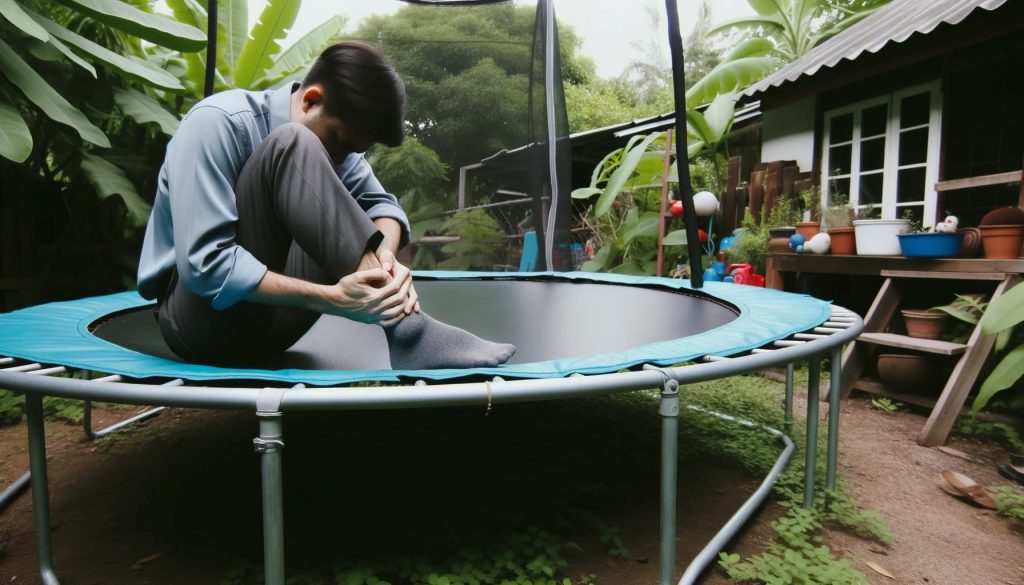Are trampolines dangerous for adults? The answer is Yes and no. Generally, it is safer to jump on a trampoline, even as an adult. But turns out it can be dangerous too sometimes. In fact, trampolines are one of the leading causes of sports-related injuries in kids and adults alike.
So, before you take a leap, here are the things you need to know about the risks of adult trampolining.
Most Common Trampoline Injuries

There are a few different types of injuries that are commonly associated with trampolines. These include:
Fractures
Fractures are one of the most common injuries associated with trampoline use. The most common fractures are those of the arm, wrist, and ankle.
Sprains and Strains
Sprains and strains are also common injuries associated with trampoline use. The American Academy of Pediatrics (AAP) estimates that nearly 50 percent of all trampoline injuries are sprains or strains. The most common areas affected are the neck, back, and shoulders.
Tendinitis
Tendinitis is an overuse trampoline related injury that can be caused by repetitive jumping on a trampoline. It is most common in the Achilles tendon or the shin.
Stress fractures
Stress fractures are another type of overuse trampoline injury that can be caused by repetitive jumping on a trampoline. They are most common in the lower extremities, such as the shin or the foot.
Ways to Reduce Risk of Trampoline Injuries
There are a few things you can do to reduce the risk of trampoline injury. These include:
Wearing protective gear
Wearing protective gear, such as padding or wrist guards, can help to reduce the risk of injury.
Avoiding Flips and Other Tricks

Flips and other tricks are one of the leading causes of injuries associated with trampoline use. If you are not a trained gymnast, it is best to avoid these maneuvers.
Keeping a Spotter Around the Trampoline
A spotter can help reduce the risk of trampoline accident by providing an extra pair of eyes to watch for dangerous situations.
Following the Guidelines
Sometimes, trampolines can fall if not assembled correctly. So, it is very important to assemble a trampoline by following the manufacturer’s instructions.
Using Enclosure Net

When using a trampoline, you must use a trampoline safety net. This will keep you on the trampoline and will not make you fall from the trampoline.
The safety net is very important. It will keep you inside when you are doing trampoline jumping.
Otherwise, it is pretty much sure you will get injured. Having an enclosure net is recommended for both kids and adults.
Checking for tears or holes

Check the trampoline for any tears or holes before each use. Do not use the trampoline if it is damaged in any way.
Using the Trampoline Only in Dry conditions
Do not use the trampoline in wet or humid conditions as this can increase the risk of severe injury.
Following the Manufacturer’s Weight Limit
Make sure to never exceed the manufacturer’s weight limit, as this can increase the risk of injury.
Wearing protective gear
Wearing protective gear, such as padding or wrist guards, can help to reduce the risk of injury.
Those are some of the most common ways to get rid of possible trampoline injuries. Be it in the backyard or be it in a trampoline park, there is always a chance of getting yourself injured. So, be aware while doing a trampoline exercise or anything related to trampolines.
Can Adults Use Trampolines Safely?

Yes, adults can safely use trampolines if they follow some simple safety guidelines.
As stated above, adults should avoid using trampolines without supervision, and they should also make sure to use proper safety equipment such as a trampoline enclosure.
Also, it’s important for adults to be aware of their own physical limitations when using a trampoline, and they should avoid attempting any risky tricks or flips. By following these simple safety tips, adults can safely enjoy using trampolines for recreation or exercise.
Who should avoid Trampolines Entirely?
People with Chronic Health Conditions
Several groups of people with chronic health conditions are deemed high-risk for trampoline injuries according to the articles. Those with heart conditions, diabetes, asthma, osteoporosis, obesity and other chronic diseases should not use trampolines at all due to the physical exertion required.
People with Recent Injuries or Surgeries
If you have recently had injuries, fractures or surgeries, especially involving the arms, legs, head or neck, avoid trampoline use until fully healed. The impact of jumping poses a danger of re-injury or damage to surgical sites. See your doctor for personalized advice on recovery time before trampoline use.
In summary, while trampolines can be enjoyed safely by some, several groups should avoid them entirely due to unacceptable injury risks. Following age guidelines, activity restrictions and safe use tips is key. Check with your doctor if unsure about personal health risks. Prioritizing safety helps.
Tips for choosing a safe and effective Trampoline
Here are some tips for choosing a safe and effective trampoline:
- Look for trampolines that meet safety standards: Make sure the trampoline you choose meets the safety standards set by ASTM International. Look for a label that indicates the trampoline meets ASTM standards.
- Choose the right size: Trampolines come in a variety of sizes, so make sure you choose one that fits the space you have available and the number of people who will be using it. A smaller trampoline may be a better choice if you have limited space or younger children.
- Check the weight limit: Make sure the trampoline you choose can safely support the weight of the people who will be using it. Different trampolines have different weight limits, so check the specifications carefully.
- Consider the shape: Trampolines come in round, rectangular, and square shapes. Round trampolines are generally considered safer because they direct jumpers toward the center of the mat, while rectangular and square trampolines allow jumpers to bounce off the edges.
- Look for safety features: Choose a trampoline that has safety features such as padding over the springs and a net enclosure to prevent jumpers from falling off.
- Consider the location: Choose a flat, level area with plenty of space around the trampoline to avoid injuries.
- Read reviews and ask for recommendations: Read reviews from other customers and ask for recommendations from friends or family members who own trampolines to help you make an informed decision.
Remember, trampolines can be dangerous if used improperly. Always supervise children while they are using the trampoline and follow all safety guidelines.
By following these tips, you can choose a safe and effective trampoline for your family to enjoy.
Conclusion
There’s no denying that trampoline jumping is fun. After all, jumping is a great way to get your heart rate up and get that endorphin rush.
Adult trampolines come with their own set of risks and dangers, but we have to keep in mind that they’re meant to be recreational as much as they’re meant to be fun.
So before you take your jump, make sure to research well and take as many precautions as possible.
Sources:
- Trampoline injuries. A study by M Nysted, J O Drogset
- 8 Best Mini Trampoline For Seniors | Detailed Review - May 11, 2023
- What is the Best Outdoor Trampoline For Adults? - May 10, 2023
- How To Keep Trampoline From Blowing Away (Best Way To Anchor A Trampoline) - May 9, 2023

